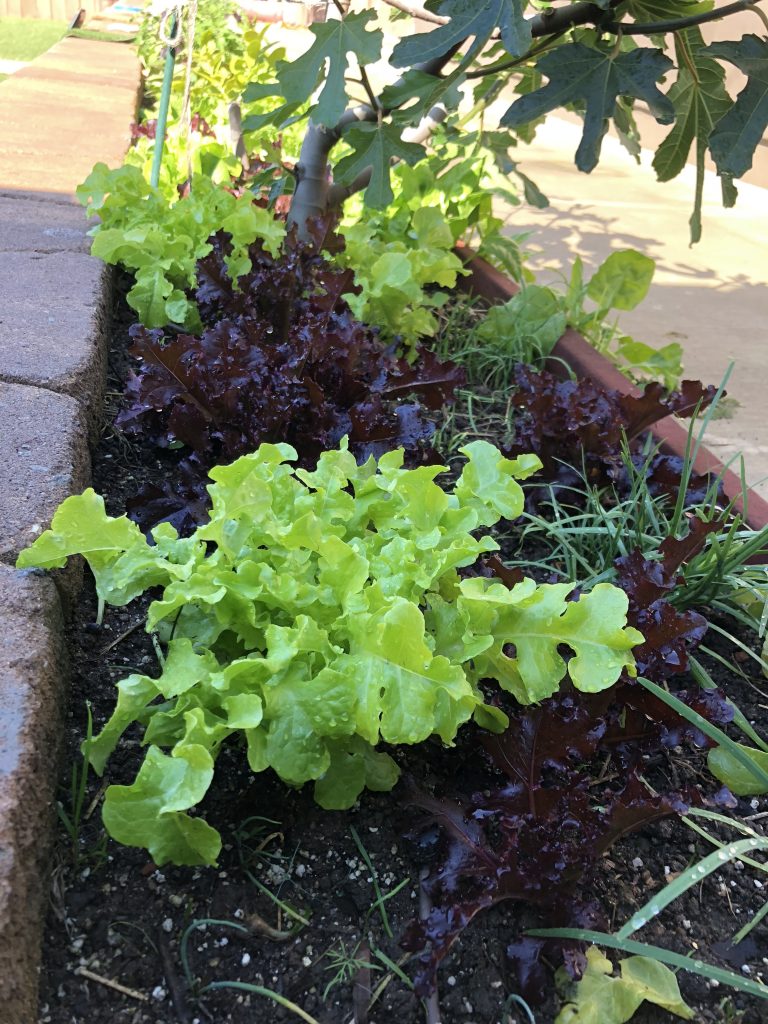Rain Barrels are Awesome! Rain water harvesting sounds very romantic.

April 12, 2020
by drplasticpicker
It has been a wet spring in Southern California, and our rain barrels have been overflowing. The country is still under COVID-19 quarantine orders, but I have been gratified that this blog has seen an uptick in traffic – hopefully providing everyone with some entertainment. This has motivated me to keep on writing. Anyway, our rain barrel makeshift collection system caught 395 gallons of water yesterday. My mother-in-law will use it over the course of the next few weeks to water her garden. Her garden is truly a work of wonder where in the normal sized front yard she is able to yield enormous amounts of lettuce, kale, onions, tomatoes, lemons, and different varieties of squash.
My own mother is a gardener too. Now that I am in my 40s, I am trying to learn from both of them. I know I am very lucky to live with my mother-in-law, and live within a few miles of my own mother. My daughter and I started sprouting potatoes and started with succulents that are now propogating and growing well. Step by step.
One way I did contribute to our garden is that I bought rainbarrels about four years ago. I purchased them through a San Diego County sponsored rebate program that has been modified but still doing on https://www.rainwatersolutions.com/products/sandiego. If you live in San Diego Unincorporated area the $90 Rain Barrel after rebates will cost you $25 and in San Diego City will cost you $55. I got it during a different rebate period and got it for even less. We have the maximum of 2 that are sponsored. We also got to visit a really neat organization, the Solana Center for Environmental Innovation https://www.solanacenter.org/resources/conserve-protect-water. Each rain barrel holds about 50 gallons of rain. We use also several different containers we have around the house, and in total with the last rainstorm we caught almost 400 gallons of rain.
Anyone who has grown up in Southern California has lived through several droughts. I remember in Junior High and 7th grade, and learned the song from a classmate that now lives in Arizona “If it’s mellow let it yellow. If it’s brown, flush it down.” That was a long and difficult drought, and I think going through adolescence at the same time made it even more memorable. That is why any rain is a miracle to me.
Rain water harvesting also helps us decrease storm water run off into the oceans. We use the water mostly for the garden, but occassionally I’ll use it to rinse off and clean some of the backyard patio furniture that needs to be cleaned. Our crazy black puppy also occassionally uses indoor reusabe pee-pee pad stations, and I rinse the plastic base and the fake grass she uses. We just watched a fantastic movie “Biggest Little Farm” and even Mr. Plastic Picker was glued to the small screen https://www.latimes.com/home/la-hm-biggest-little-farm-documentary-apricot-lane-biodynamic-farm-20190510-story.html. In that movie and other environmental series, the use of rainwater and improved soil quality also improved water absorption into the soil and recharged aquifers. I mentioned this to our daughter as a reason why it’s important to improve soil quality and catch rain water, but on further reading in our area we don’t really have high quality aquaifers. They are mostly brackish saline collections. According to the San Diego Water Authority website, “Production of groundwater as a water supply to the San Diego region requires the extraction of water from underground reservoirs, known as aquifers. Groundwater in the San Diego region is mostly found as saline brackish water. Brackish water requires an additional desalination treatment process. Groundwater production in the Water Authority’s service area is limited by a number of elements, including lack of storage capacity in local aquifers, availability of groundwater recharge, and degraded water quality” https://sdcwa.org/groundwater. Well at least, we are preventing more storm drainage run off into the ocean and reducing use of potable water by rainwater harvesting.
I thought I was going to write this revolutionary post about our rain barrels. But that is it. We have rain barrels and we use other buckets, and I listed the website where you can get them and get rebates to save some money. At least writing this post distracted me from thinking about COVID-19, and I got to think about rainwater harvesting which sounds so romantic. And I got to dream that we were like the Los Angeles couple that devoted 7 years to regenerative agriculture in that fantastic movie “Biggest Little Farm.” Much easier to buy $15 eggs from them and catch some rain water than devoting seven years to that endeavor. Such an interesting movie. I wonder who the anonymous financier is? I think it may be Tom Steyer? Who knows.



I live in Ontario Canada, where we get our share of rainfall during the summer months and into early fall. Just a few weeks ago I encountered a program consisting of rain barrel and the useful ways that you can implement them. With that being said I was hooked on the idea. I now have a set of twins in my backyard connected to each other. At first I to convince my wife about the idea and how the rain water is better for plants. There will be a garden hose attached and a pump to complete the irrigation project.
Thank you for stopping by drplasticpicker Carlos! So glad there are other municipalities with the rain barrel programs. It just makes so much sense to avoid run off and pollutants, and water conservation as well. I agree with you, if you can convince your significant other than that’s often the hardest battle. I usually know I’m on to something if Mr. Plastic Picker is on board. So glad to meet another rain water harvestor!